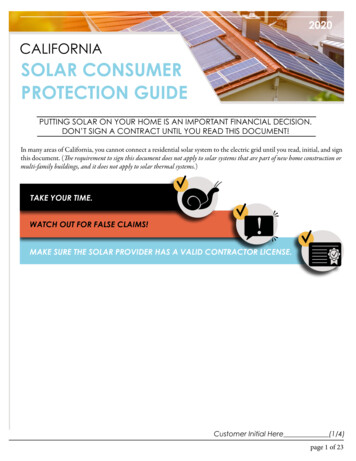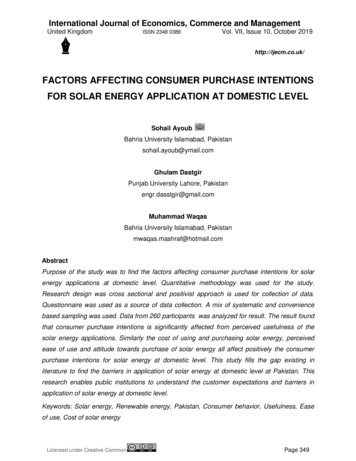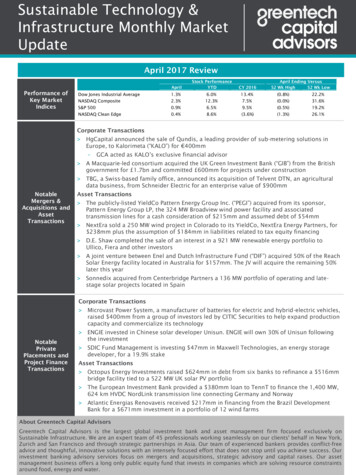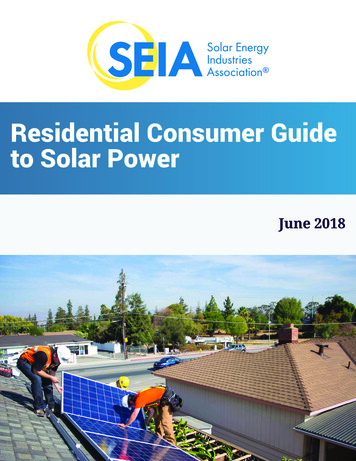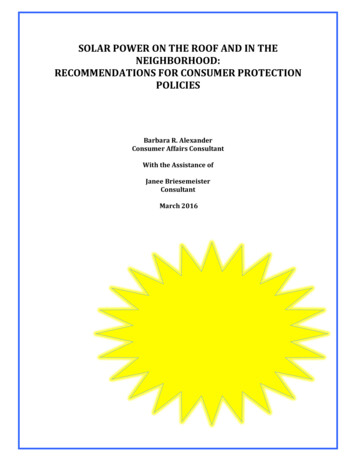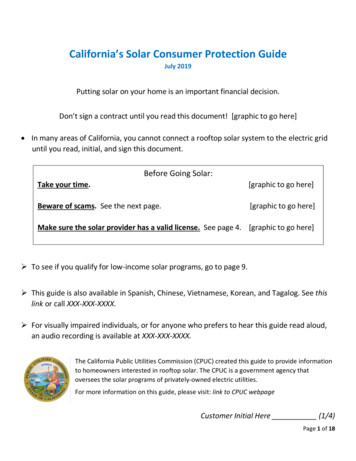
Transcription
California’s Solar Consumer Protection GuideJuly 2019Putting solar on your home is an important financial decision.Don’t sign a contract until you read this document! [graphic to go here] In many areas of California, you cannot connect a rooftop solar system to the electric griduntil you read, initial, and sign this document.Before Going Solar:Take your time.[graphic to go here]Beware of scams. See the next page.[graphic to go here]Make sure the solar provider has a valid license. See page 4. [graphic to go here] To see if you qualify for low-income solar programs, go to page 9. This guide is also available in Spanish, Chinese, Vietnamese, Korean, and Tagalog. See thislink or call XXX-XXX-XXXX. For visually impaired individuals, or for anyone who prefers to hear this guide read aloud,an audio recording is available at XXX-XXX-XXXX.The California Public Utilities Commission (CPUC) created this guide to provide informationto homeowners interested in rooftop solar. The CPUC is a government agency thatoversees the solar programs of privately-owned electric utilities.For more information on this guide, please visit: link to CPUC webpageCustomer Initial Here (1/4)Page 1 of 18
If you are considering signing a contract for a rooftop solar system,make sure to read at least the next 3 pages.1) Beware of Solar ScamsThere are many honest and fair Solar Providers in California. However, there are also scams and misleadingadvertising that you should watch out for. See below for some common scams.Scam:A salesperson promises you free rooftop solar energy at no cost to you.The Truth:Rooftop solar energy is almost never free. An honest company will be up front about allthe costs you will pay over time.o There is one exception: some government-funded solar programs offer free or lowcost solar to low-income households. See page 9 for more details.Scam:A salesperson tells you that you will never pay an electricity bill everagain after you install a solar system.The Truth:You will still receive an electricity bill from your utility after going solar. Most rooftopsolar customers still pay at least a small electricity bill every month, with a largerpayment due to the utility at the end of a 12-month cycle.o Customers who take out a solar loan or sign a lease or power purchase agreementwill also receive a monthly bill from a loan company or solar provider. If you usePACE financing, your payments will be due once or twice a year with your propertytaxes or monthly with your mortgage payment.Scam:A salesperson insists that you sign an agreement on an electronic tabletwithout showing you the contract terms.The Truth:California law requires that a salesperson show you the contract terms before you sign.An honest salesperson would never rush you to sign anything, especially on a tablet,without giving you the time to review all the paperwork.o By law, the contract must be written in the same language the salesperson used tosell you solar.If you think you have been a victim of solar fraud, report the incident to the Contractors State License Board(CSLB) at XXX-XXX-XXXX or at this link.Customer Initial Here (2/4)Page 2 of 18
2) Know Your Rights[graphic to go here]YOU HAVE THE RIGHT to a 3-day cancellation period after signing a contract.You have three business days to cancel your contract for any reason. You may cancel the contract by emailing,mailing, faxing or delivering a notice to your solar provider by midnight of the third business day after youreceived a signed, dated copy of the contract. If your solar provider refuses to cancel the contract, report them to the Contractors State License Board(CSLB) at this link.YOU HAVE THE RIGHT to a Solar Disclosure Document from your solar provider.By law, a solar provider must provide a Solar Energy System Disclosure Document created by the CSLB andCalifornia Public Utilities Commission. This document provides you with information about your solar system,such as total costs. See this document at this link and learn more on page 15.YOU HAVE THE RIGHT to read this entire 18-page guide before signing a contract.If you are a PG&E, SCE, or SDG&E customer, a solar provider must give you the time to read and sign this guidebefore you sign a contract for solar. If they do not allow you to read this document, they cannot interconnectyour solar system to the electric grid.YOU HAVE THE RIGHT [placeholder][This right is a placeholder until after AB 1070 (Gonzalez Fletcher, 2017) Section 3 is implemented throughCPUC’s R.14-07-002 stakeholder process]Customer Initial Here (3/4)Page 3 of 18
3) Ask a Solar Provider These Questions Before You Sign a Contract. What is your Contractors State License Board (CSLB) license number?o Ask for a proof of the license. You can check the license to make sure it is valid by going to this linkor calling XXX-XXX-XXXX. CSLB License Number is: .o If your solar provider does not have a valid license, do not sign a contract with them. What is the total amount of payments I will make over the entire contractperiod for solar?o If you are considering a solar loan, lease, or power purchase agreement, ask if there is a downpayment, how you much you will pay per month, when these payments will increase, and by howmuch.o If you are considering PACE financing, ask how much you will pay once or twice a year with yourproperty taxes or monthly with your mortgage. Ask how many years you will pay this amount. How will a solar system impact the sale or refinancing of my home?o Ask your solar provider to show you where in the contract it describes what happens when you sellyour home.For more questions to ask a solar provider, go to page 7 of this guide.[pop out box]Make sure to get 3 bids from differentsolar providers before you sign acontract. See page 7 of this guide formore details. OK, I read these 3 pages. Now what? For a step-by-step guide for how to go solar, proceed to the next page. This isrecommended, even if you’ve already started the solar process! If you want to skip to the “Before You Sign” checklist, please go to page 17 of this guide.Customer Initial Here (4/4)Page 4 of 18
Roadmap for Rooftop SolarThe information below will be a graphic similar to this:Step 1: Decide if Rooftop Solar Is Right for YouStep 2: Understand Roles and the Rooftop Solar ProcessStep 3: Find a Qualified ContractorStep 4: Compare Financing OptionsStep 5: Learn About Electricity Bill SavingsStep 6: Carefully Read All PaperworkStep 7: Check Off the “Before You Sign” ChecklistStep 8: Sign This Guide Step 1:Is Rooftop Solar the Right Choice for Me?Rooftop solar photovoltaic panels capture sunlight on your roof and convert it into electricity.This electricity powers the needs of your home, like lights and appliances.1[graphic to go here]Before you consider getting rooftop solar, ask yourself: Have I made my home energy efficient first?o Making your home energy efficient before going solar can decrease your overall energy use andreduce the size of the solar system you need, potentially saving you thousands of dollars. Call yourutility or check their website for energy efficiency tips and advice on how to get an in-person homeenergy assessment.Do I qualify for low-income solar programs?o If you think you might qualify for a low-income solar program, go straight to page 9 of this guide.There are rooftop solar and community solar programs available for qualifying low-income PG&E,SCE, and SDG&E customers that could save you more money with no financial risk.Have I considered community solar?o If you are a PG&E, SCE, or SDG&E customer, you can sign up for a community solar program andreceive 50-100% of your electricity from solar projects located across California. This could be agood option for you if your roof is heavily shaded or isn’t in great condition. Check out this link. 1Note that solar panels can also be ground-mounted on your property.Page 5 of 18
Step 2:Understand Roles and the Rooftop Solar ProcessSolarProviderLender orFinancerSalespersonCity mAdmiinistratorManufacturerInstallerSolar Providers are the companies that sell you solar and sendinstallers to your home. Sometimes they provide financing.[Question for stakeholders: should we use the term “SolarCompany” throughout the guide instead?]Salespeople work for Solar Providers and may call you orknock on your door. Similar to Solar Providers andInstallers, they must be registered. Check their “HISregistration” at link or by calling XXX-XXX-XXXX.Installers are sent by Solar Providers to your home to conductsite visits and install the solar system.Lenders or Financers provide you with financing if you have asolar loan or PACE financed system.Electric Utilities interconnect your rooftop solar system to theelectric grid and send you electricity bills that may includesolar bill credits.Program Administrators manage PACE financing programs.They must be licensed. Check their license at this link.Manufacturers are the companies you would contact aboutequipment warranties if you own a solar system.City/County Inspectors come to your home to make sure thesystem is up to code in order to get a permit.Overview of a Sample Rooftop Solar ProcessBefore you sign a contract1)2)3)4)5)6)7)8)9)You You .Solar Provider .You .Solar Provider .You .Lender/Financer .You .You . .get a home energy assessment to make your home more energy efficientresearch Solar Providers and compare 3-6 bidsprovides a Solar Disclosure Document based on your roof and energy usereview the Solar Disclosure Document with Solar Provider and ask questionswrites up solar contractqualify for financing (if needed)writes up financing agreement (if needed)go through checklist on p. 17 of this guidesign this guide, Solar Disclosure Document, solar contract, and financing agreementAfter you sign a contract1)2)3)4)5)6)7)8)9)Installer Solar Provider .Installer . .City/County InspectorSolar Provider Solar Provider .You .Electric Utility .Lender/Solar Providerperforms a home site visit to confirm assumptions and check roof/electric conditionsapplies for building permit with city or county agencyinstalls the solar system (only after receiving city/county permit)inspects home for building permit compliancesubmits application to utility to interconnect solar system to gridsubmits city/county inspection approval to utilityturn on system only after receiving written approval from utilitysends you your first electricity bill with solar/net energy metering credits (see page 13)sends you first bill for solar system or solar energyPage 6 of 18
Step 3:Find a Qualified Solar ProviderFind Solar Providers that Serve Your Neighborhood Go to www.CaliforniaDGStats.ca.gov, a government-funded website, to enter your zip code and see a list ofSolar Providers and their recent installation costs.Refer to the Contractors State License Board (CSLB) List of Solar Providers at this link.Check to see if your county has a County Contractor’s Association with Solar Providers.Research solar panel brands and search manufacturer website for Solar Providers that sell them near you.Ask a community-based group, or friends and neighbors, for Solar Providers they recommend and why.Narrow Down the List to Qualified Solar Providers First, make sure Solar Providers you consider have a valid license from the Contractors State License Board(CSLB). It is illegal for Solar Providers and their Installers to conduct business without a license.o Go the CSLB website at link or call XXX-XXX-XXX to see if the Solar Provider and Installer licenses arecurrent and valid. The licenses must be in the category C-10, C-46, A or B.Find out how long the company has been in business and how many installations they have done.Check out customer review websites online. Since some websites may not be neutral, check a few differentwebsites to make sure reviews are consistent.It’s a good sign if companies employ installers certified by the North American Board of Certified EnergyPractitioners (NABCEP), a high standard in the industry.Get Bids From 3 to 6 Qualified Solar Providers and Ask Questions After you narrow down the list of Solar Providers, ask for a bid or price quote.o Note that the best option for you is not necessarily the cheapest bid. A very low bid may indicate that aSolar Provider is trying to cut corners.Don’t hesitate to ask Solar Providers lots of questions up front. A qualified company will be happy to answer allof them. A sample list of questions is below.Sample Questions to Ask a Solar ProviderCompany Background What is your company’s license number from the Contractors State License Board (CSLB)? What isyour Installer’s license number? Will you subcontract to another company to install the solar system? If so, what is their CSLB number? How long have you been in business and how many systems have you installed? Can you provide me with three customer references to call?Design and Roof Why did you choose this specific design and size? Note that a system sized to cover all of your energy use isn’t necessarily the best investment.Typically, a system is sized to around 80% of your electricity use from the previous year. Does my roof need to be replaced before installing solar panels? If yes, how much will that cost, who will do it/what is their license #, and is there a roof warranty? What steps will you take to ensure my roof won’t leak? How much will it cost to remove and re-install the panels if I need to replace my roof down the road,including inspection fees?Continued on next pagePage 7 of 18
Sample Questions to Ask A Solar Provider, ContinuedEstimated Electric Bill SavingsPlease beware of a solar provider that tells you solar is free—it is not. See page 2 for info on solar scams. This bullet is a placeholder until AB 1070 implemented through CPUC’s R.14-07-002 stakeholder process. What electricity rate do you recommend I switch to and why? How long will I be on that rate, and how can I compare or change rates on my utility website?Warranties and Performance of Solar System Are there warranties for the panels and inverters? If yes, how long do they last and who do I contact to replace these components? If equipment such as the inverter fails after the warranty period, how much will it cost to replace? Are there warranties for labor/construction? Are repairs and maintenance included in the contract? If yes, who should I contact for repairs? Will I be able to monitor the performance of the system once it’s installed? If so, how? Does the solar provider offer a minimum energy guarantee (common with leases/power purchaseagreements)? If yes, how will I be paid if the system does not produce as much energy as promised in the contract? Is there an insurance policy that comes with the solar system, or do I need to take out additionalhomeowner’s insurance? Note that this is especially important if you live in fire-prone areas. What are my obligations in the contract if my solar system stops working due to a disaster like anearthquake or a fire? Who has the right to claim the environmental benefits of the power generated by my system?Impacts on Future Sale of Your Home How will a solar system impact the home sale and refinancing of my property?For leases, power purchase agreements (PPAs), and PACE financed systems: What happens if the home buyer doesn’t want the solar system or doesn’t qualify to take on mylease, PPA or PACE financed system? Are there fees if I need to terminate the contract early to sell my house? Are there fees for transferring the lease, PPA, or PACE financing to a new homeowner?Timeline When do you propose to start and finish installing solar on my roof? After installation is complete, how long do you estimate it will take for my utility to interconnect mysystem to the grid?Want to know questions to ask a lender or financer? Keep reading because those are in the next sections!Page 8 of 18
Step 4:Compare Your Financing OptionsThere are many financing options for rooftop solar. Before you invest time researching those options, STOP!First check to see if you qualify for any low-income solar programs below. If you qualify, these solar programswill save you more money without any financial risk.Low-Income Solar Programs available to PG&E, SCE, and SDG&E eligible customersIf you currently receive a discounted electricity bill through the CARE or FERA program, you may qualify forone of these programs.You may also qualify for one of these programs if you live in a disadvantaged community (DAC). A DAC is aneighborhood vulnerable to multiple sources of pollution. To find out if you live in a qualified DAC, check outthe map at this link.SASH Program and DAC-SASH ProgramThe SASH Program provides discounted rooftop solar for qualifying low-income homeowners wholive in affordable single-family housing. If you qualify, your family can get assistance installing solar ata low cost.The DAC-SASH program is designed for CARE or FERA eligible homeowners that live in adisadvantaged community (DAC). Homeowners do not need to live in a home defined as affordableto qualify but must live in a qualified DAC. See this link or call XXX-XXX-XXXX for more information on eligibility and how to sign up.DAC-Green Tariff ProgramThe DAC-Green Tariff Program is designed for CARE or FERA eligible households that live in adisadvantaged community (DAC). Participants can have 100% of their electricity offset by solargeneration and receive 20% discount on their electricity bills.In this program, you do not have to install solar on your roof. The solar is installed elsewhere and thebill credits are assigned to you. See this link or call XXX-XXX-XXXX for more information on eligibility and how to sign up.Community Solar Green Tariff ProgramThe Community Solar Green Tariff Program allows households in a disadvantaged community tosubscribe to a solar array within 5 miles of their neighborhood and receive a 20% discount on theirelectricity bills. See this link or call XXX-XXX-XXXX for more information on eligibility and how to sign up.If you are not a PG&E, SCE or SDG&E customer, call your electric utility-- or check their website-- to see if anylow-income solar options are available to you.Page 9 of 18
Most CommonRooftop SolarFinancing OptionsPurchase(Cash or Loan)PACE FinancingLeasePower PurchaseAgreement(PPA)Side-By-Side Quick Financial ComparisonProsConsPurchase Typically greater return on investment.May increase value of home.You can directly receive tax credits anddeductions. PACE Financing Lease and PPA Little or no upfront costs.May have a longer repayment periodthan typical home improvement loan.You can directly receive tax credits anddeductions. Little or no upfront costs.Solar Provider is responsible for allmonitoring, maintenance and repairs.Minimum energy production oftenguaranteed. You are responsible for repairs andmaintenance, which may involvecontacting different manufacturers, whocould go out of business during the 1020 year component lifecycles.Some solar loans place a lien on yourproperty. If you do not make yourpayments, this could result inforeclosure or complicate homesale/refinancing.PACE financing results in a first-prioritylien on your property. If you do notmake your payments, this could result inforeclosure or complicate homesale/refinancing.You are responsible for repairs andmaintenance, which may involvecontacting different manufacturers, whocould go out of business during the 1020 year component lifecycles.Selling home is more complicated thanwith a purchased system, since newowner must agree to take on thelease/agreement or you must buy outthe lease/agreement, which could bethousands of dollars.Solar Provider could go out of businessduring the contract period.PurchaseYou can purchase a solar system from a Solar Provider or Manufacturer with a solar loan or cash. In thisapproach, you own the installed system. Types of loans include:Page 10 of 18
Secured loans: these require an asset that will serve as collateral for the loan – in most cases, thatasset is your home, similar to a home equity loan.Unsecured loans: these do not require any collateral other than the solar panel system.Typically, a secured loan is preferred because it is tax deductible and has lower interest rates.Many Solar Providers work with lenders that offer solar loans, but you should check with banks and creditunions as well. Compare offers to make sure you are being offered a reasonable interest rate.If you purchase and begin construction on a solar system before December 31, 2021, you can deduct between22% and 30% of the cost of installing solar from with a federal solar tax credit (ITC). If you have questionsabout the ITC or whether a loan is tax deductible, speak to a Certified Public Accountant (CPA) for tax advice.Since you will be responsible for any maintenance and repairs, make sure you save the equipment warranties,particularly for the inverter, which may need to be replaced sooner than other equipment. If you sell yourhome, look for real estate agents and appraisers with experience selling homes with solar. You may includethe system in the house sale just like any other major home component.Questions to Ask a Lender About the Purchase of a Solar System with a Loan: What is the total cost of the loan over the entire course of the contract? How much will I pay up front, how much over time, and for how long? What is my interest rate? Who do I contact if I have questions about my loan payments? How does a solar loan affect the ability to sell or refinance my home?PACE (Property Assessed Clean Energy)PACE is a financing option that is available in some areas of California. In a PACE financing arrangement, aPACE Program Administrator finances the upfront costs of a solar system, which you then pay through anassessment on your property tax bill. With PACE financing, you own the solar system.PACE financing lasts for a fixed term, typically around 10-20 years, and it is attached to your house. If you sellyour house before you have fully paid the PACE assessment, a buyer may require you to repay the assessment,which could be thousands of dollars. Some mortgage lenders will not loan money to buyers to purchaseproperties with PACE liens unless the full assessment is paid.Unlike Leases and Power Purchase Agreements that require monthly payments, PACE assessments aretypically due once or twice a year with your property taxes. Given this unique arrangement, it’s important tounderstand how much you will owe and when, so that you can set aside enough money throughout the yearto cover the amount.If your house is mortgaged and you typically pay your taxes with an escrow or impound account, yourmortgage company may increase the amount you must pay monthly to cover the anticipated increase to yourproperty tax bill. Discuss how PACE will affect your monthly mortgage payment before you sign an agreement.Page 11 of 18
Questions to Ask a PACE Program Administrator About a PACE financed System: What is the total cost of the financing over the entire course of the contract? How much will I owe for PACE financing when I pay my mortgage or property taxes? How many times a year will I owe this PACE payment? What happens if I want to sell or refinance my home? Is there anything I have to do with themortgage company? What are the penalties for failing to pay the assessment on time? Who do I contact if I have problems making my PACE payments?Lease and Power Purchase AgreementWith a Lease, the Solar Provider owns the system on your property and “rents” it to you for a set period oftime. A Solar Provider will install the solar system on your home, and you will make scheduled monthlypayments in exchange for all the electricity the system produces. A typical Lease contract period is 15-25years.In a Power Purchase Agreement (PPA), the Solar Provider owns the system on your property and sells you theelectricity it generates. PPAs are similar to Leases, except that instead of making a fixed monthly payment forthe system, you pay for every unit of energy the solar system generates (a fixed per-kilowatt-hour rate). Thecontract will specify the kilowatt hour rate you pay in the first year and every year after that. This rate shouldbe lower than your current utility rate. A typical PPA contract period is 10-25 years. If you sell your house before the Lease or PPA contract is over, you will have to pay the Solar Provider theremainder of the value of the Lease or PPA or transfer the contract to the new property owner. Make sureyou understand the specific contract terms, since buying out a Lease or PPA can cost thousands of dollars. Payments for both Leases and PPAs will typically increase by a specified amount every year based on an“escalation clause” or “escalator.” Escalators are typically in the range of a 1% to 3% increase above therate you paid in the previous year. Be cautious of entering into a contract with an escalator higher thanthat. There are different ways to arrange Leases and PPAs, such as paying more up front to reduce your monthlypayments.Questions to Ask a Lender or Solar Provider About a Lease or PPA: What is the total cost of the solar system or solar energy over the entire course of thecontract? How much will I pay up front, how much over time, and for how long? Will my payments increase over time? How much will they increase, and howfrequently? Is there an option to make a down payment to reduce my monthly payments (for aLease) or kilowatt hour rate (for a PPA)? What happens if I wish to end the Lease or Power Purchase Agreement early? Will I owe a balloon payment and/or an early termination fee? If so, how much will IPage 12 of 18owe? How does a Lease or PPA affect the ability to sell or refinance my home?
Step 5:Learn About Electricity Bill SavingsElectricity Bill Savings Estimates—What You Need to Know[After AB 1070 implemented through CPUC’s R.14-07-002 stakeholder process, additional text will go here]Electricity Bill Savings Estimates Do Not Guarantee SavingsAn electricity bill savings estimate is an educated guess about how much you could save with rooftop solar.Here are some reasons why it’s possible that your savings could be lower than the estimate: Electricity bill savings estimates are based on several uncertain factors. For example, the estimatesinclude a forecast of your electricity use based on your previous usage. If your family grows or youdecide to turn up your Air Conditioning in the summer, your energy usage will go up, and your overallsavings could go down. Electricity rates can change over time. Your utility may require you to switch to a different rate in thefuture, which would change how much you save. If you sell your home, you could incur additional costs. For example, if a buyer doesn’t want to take on aLease or Power Purchase Agreement, you might have to buy out the contract, which could be thousandsof dollars.Before you sign a contract, ask yourself: if the savings end up being lower than the estimated monthly oryearly savings, does getting rooftop solar still make sense to me?How Electricity Bill Savings WorkThere is a special arrangement with your utility that is called Net Energy Metering (NEM). NEM allows you toget a financial credit on your electricity bill when your rooftop solar system sends electricity back to the gridafter first powering electricity needs at your house. Usually this credit is approximately equal to the retail rateof energy. This means that you are credited on your bill about the same amount that your utility would havecharged you for electricity during that time.NEM and Your Electricity BillSince the sun isn’t always shining, solar customers also rely on electricity from their utility. After your solarsystem is interconnected to the grid, your monthly electricity bill will summarize how much electricity youdrew or “consumed,” from the utility, and how much your solar system sent to the grid or “exported.”If you drew in more than you sent out to the grid in any given month, you will see an overall charge on yourbill. If you sent out more than you drew in, you will see an overall credit. Typically, you will be able to carryforward credits to the next month’s bill, and electricity usage charges will not be due until the end of a 12month period. Note that many utilities require solar customers to pay a monthly minimum bill each monthjust like other utility customers.Page 13 of 18
12 Month “True Up” BillAt the end of a 12-month period, you will receive a “True Up” bill that reconciles all the credits and charges.Even though going solar can reduce your electricity costs, most customers still owe some money to their utilityat the end of the 12 months. Some utilities give you the option to pay your bills monthly instead of annually. Ifyou choose this option, you won’t have to worry about paying for one potentially large bill at the end of theyear.Though it’s rare, if you have an electricity credit balance at the end of the 12-month period, you are eligible tobe paid “net surplus compensation,” which is around 2 to 3 cents per kilowatt hour. Because this rate is lowerthan the retail rate, it is generally not in your financial interest to install a solar system that produces moreenergy than you would use over the course of a year.Customers in PG&E, SCE, and SDG&E territories are guaranteed NEM for 20 years from the time their solarsystem starts operating. Your electricity rate, however, is subject to change. See this CPUC link for moredetails.Getting Environmental Credit for
California's Solar Consumer Protection Guide July 2019 Putting solar on your home is an important financial decision. Don't sign a contract until you read this document! [graphic to go here] In many areas of California, you cannot connect a rooftop solar system to the electric grid until you read, initial, and sign this document.



